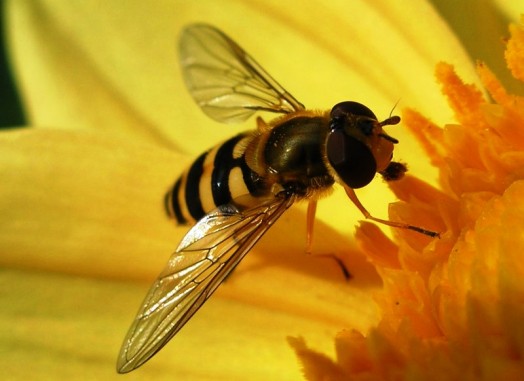

#Black bee looking insect professional
You may choose to hire a certified pest management professional to provide this service. Individual carpenter bee nests can be treated with insecticide dust or with "wasp and hornet" aerosol spray. Painted or pressure-treated wood is much less susceptible to attack and a coat of paint or a heavy stain will protect wood from further attack. Activity resumes in April or May when the process of producing the next generation is repeated.īare, unpainted or weathered softwoods are preferred, especially redwood, cedar, cypress and pine. After a brief period of feeding in August or September, the bees return to the tunnels to spend the winter. The larvae feed on the nectar and pollen and develop into adults by late summer. She continues this process until 6 to 10 cells are constructed. She lays an egg on this "bee bread" and builds a partition in the tunnel with cemented wood chips.

Inside the tunnel the female places a mixture of pollen and nectar. Female carpenter bees can inflict a painful sting but seldom will unless they are handled. Male carpenter bees appear aggressive as they hover around the nests and make a show of attempting to defend their "territory." However, males do not have stingers and are harmless. The bees may be noticed hovering around the outside of homes, barns and sheds in late-spring to early summer as the bees search for mates and favorable nesting. Old tunnels may be enlarged and reused and it is not unusual for the bee to excavate several tunnels from a single opening.Ĭarpenter bees are often discovered by the large quantity of coarse sawdust that falls from the nest openings, or homeowners may hear burrowing sounds within the wood. Bees prefer lumber that is more than 2 inches thick. The tunnel goes straight into the wood a short distance and then makes a 90-degree turn and follows the grain of the wood for several inches. Carpenter bees are solitary and nest by drilling holes into exposed, bare wood.įemale carpenter bees tunnel into the surface of bare wood through a perfectly round hole measuring about ½ inch in diameter. Bumble bees are social (large colonies living together) and live in the ground or in existing cavities. The behavior of the two bees is much different. Carpenter bees have a bare, shiny-black abdomen, while bumble bees have a hairy abdomen with at least some yellow markings. Wood that has been used for nesting year after year may be structurally damaged.Ĭarpenter bees look like bumble bees. Carpenter bees are beneficial as pollinators. However, the tunnels made in the wood of structures is annoying and potentially damaging.

Carpenter bees are large, wood-boring insects that burrow into sound wood such as rafters, deck joists, fascia boar ds and other exposed bare wood.


 0 kommentar(er)
0 kommentar(er)
